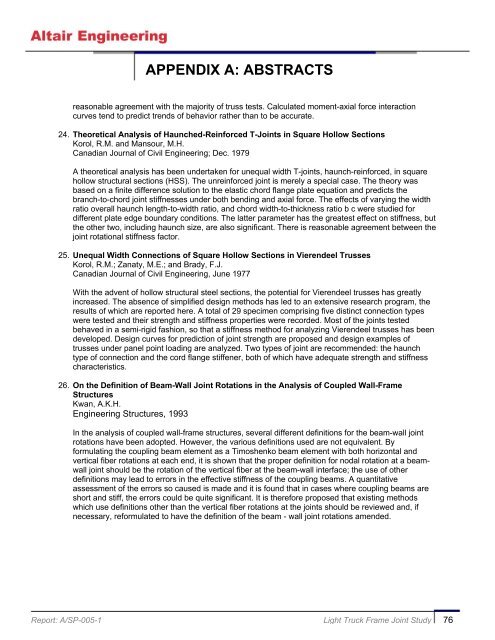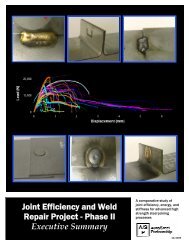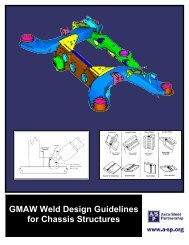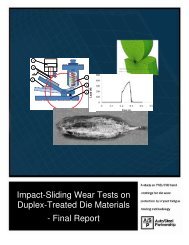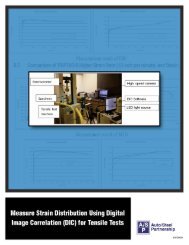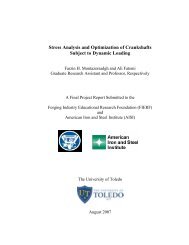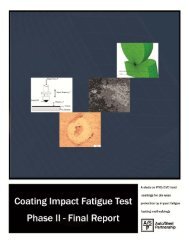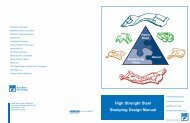Light Truck Frame Joint Stiffness Study Phase 1 Final Report
Light Truck Frame Joint Stiffness Study Phase 1 Final Report
Light Truck Frame Joint Stiffness Study Phase 1 Final Report
You also want an ePaper? Increase the reach of your titles
YUMPU automatically turns print PDFs into web optimized ePapers that Google loves.
APPENDIX A: ABSTRACTS<br />
reasonable agreement with the majority of truss tests. Calculated moment-axial force interaction<br />
curves tend to predict trends of behavior rather than to be accurate.<br />
24. Theoretical Analysis of Haunched-Reinforced T-<strong>Joint</strong>s in Square Hollow Sections<br />
Korol, R.M. and Mansour, M.H.<br />
Canadian Journal of Civil Engineering; Dec. 1979<br />
A theoretical analysis has been undertaken for unequal width T-joints, haunch-reinforced, in square<br />
hollow structural sections (HSS). The unreinforced joint is merely a special case. The theory was<br />
based on a finite difference solution to the elastic chord flange plate equation and predicts the<br />
branch-to-chord joint stiffnesses under both bending and axial force. The effects of varying the width<br />
ratio overall haunch length-to-width ratio, and chord width-to-thickness ratio b c were studied for<br />
different plate edge boundary conditions. The latter parameter has the greatest effect on stiffness, but<br />
the other two, including haunch size, are also significant. There is reasonable agreement between the<br />
joint rotational stiffness factor.<br />
25. Unequal Width Connections of Square Hollow Sections in Vierendeel Trusses<br />
Korol, R.M.; Zanaty, M.E.; and Brady, F.J.<br />
Canadian Journal of Civil Engineering, June 1977<br />
With the advent of hollow structural steel sections, the potential for Vierendeel trusses has greatly<br />
increased. The absence of simplified design methods has led to an extensive research program, the<br />
results of which are reported here. A total of 29 specimen comprising five distinct connection types<br />
were tested and their strength and stiffness properties were recorded. Most of the joints tested<br />
behaved in a semi-rigid fashion, so that a stiffness method for analyzing Vierendeel trusses has been<br />
developed. Design curves for prediction of joint strength are proposed and design examples of<br />
trusses under panel point loading are analyzed. Two types of joint are recommended: the haunch<br />
type of connection and the cord flange stiffener, both of which have adequate strength and stiffness<br />
characteristics.<br />
26. On the Definition of Beam-Wall <strong>Joint</strong> Rotations in the Analysis of Coupled Wall-<strong>Frame</strong><br />
Structures<br />
Kwan, A.K.H.<br />
Engineering Structures, 1993<br />
In the analysis of coupled wall-frame structures, several different definitions for the beam-wall joint<br />
rotations have been adopted. However, the various definitions used are not equivalent. By<br />
formulating the coupling beam element as a Timoshenko beam element with both horizontal and<br />
vertical fiber rotations at each end, it is shown that the proper definition for nodal rotation at a beamwall<br />
joint should be the rotation of the vertical fiber at the beam-wall interface; the use of other<br />
definitions may lead to errors in the effective stiffness of the coupling beams. A quantitative<br />
assessment of the errors so caused is made and it is found that in cases where coupling beams are<br />
short and stiff, the errors could be quite significant. It is therefore proposed that existing methods<br />
which use definitions other than the vertical fiber rotations at the joints should be reviewed and, if<br />
necessary, reformulated to have the definition of the beam - wall joint rotations amended.<br />
<strong>Report</strong>: A/SP-005-1 <strong>Light</strong> <strong>Truck</strong> <strong>Frame</strong> <strong>Joint</strong> <strong>Study</strong> 76


